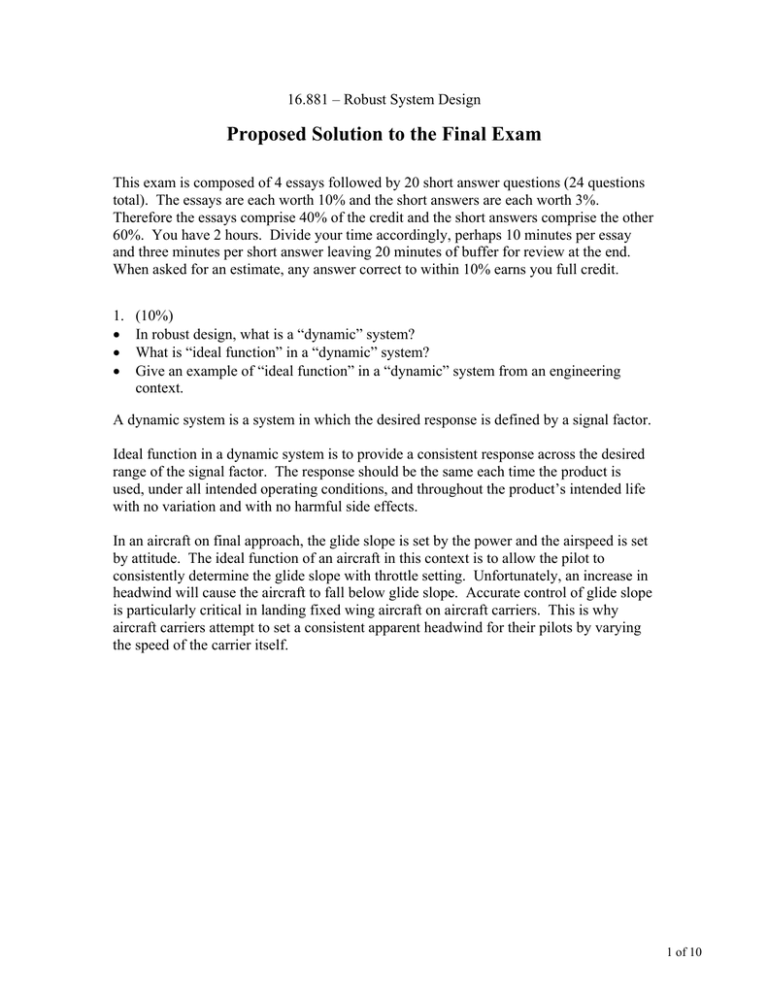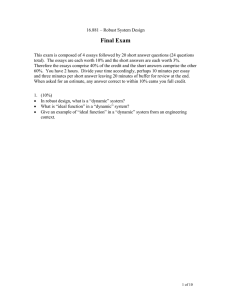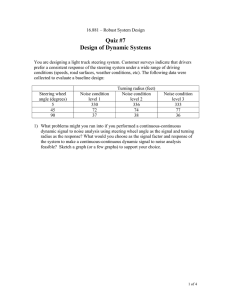Proposed Solution to the Final Exam
advertisement

16.881 – Robust System Design Proposed Solution to the Final Exam This exam is composed of 4 essays followed by 20 short answer questions (24 questions total). The essays are each worth 10% and the short answers are each worth 3%. Therefore the essays comprise 40% of the credit and the short answers comprise the other 60%. You have 2 hours. Divide your time accordingly, perhaps 10 minutes per essay and three minutes per short answer leaving 20 minutes of buffer for review at the end. When asked for an estimate, any answer correct to within 10% earns you full credit. 1. • • • (10%) In robust design, what is a “dynamic” system? What is “ideal function” in a “dynamic” system? Give an example of “ideal function” in a “dynamic” system from an engineering context. A dynamic system is a system in which the desired response is defined by a signal factor. Ideal function in a dynamic system is to provide a consistent response across the desired range of the signal factor. The response should be the same each time the product is used, under all intended operating conditions, and throughout the product’s intended life with no variation and with no harmful side effects. In an aircraft on final approach, the glide slope is set by the power and the airspeed is set by attitude. The ideal function of an aircraft in this context is to allow the pilot to consistently determine the glide slope with throttle setting. Unfortunately, an increase in headwind will cause the aircraft to fall below glide slope. Accurate control of glide slope is particularly critical in landing fixed wing aircraft on aircraft carriers. This is why aircraft carriers attempt to set a consistent apparent headwind for their pilots by varying the speed of the carrier itself. 1 of 10 2. • • • (10%) What are noise factors? What is a compound noise factor? Under what conditions would you recommend using a compound noise factor? Noise factors are that which cause a product to deviate from its ideal function. A compound noise factor is a virtual noise factor that determines the settings of several actual noise factors that affect the system being designed. The settings of the actual noise factors should be grouped so that they create the largest possible effect on the response. A compound noise factor should be used when the cost of experiments is high compared to the additional accuracy provided by other noise strategies. Compounding noise may be especially important when there are a large number of noise factors affecting the response of the system. The savings in experimental effort due to compounding noise factors rises exponentially with the number of noise factors to be considered in an experiment. 2 of 10 3. (10%) • Describe an engineering example of a system integration problem caused by insufficient robustness of the system’s components or subsystems. • Explain what failure modes occurred, what noise factors were involved, and how system level interactions came into play. When an electronic module is assembled onto a printed wiring board, it is essential that an appropriate amount of solder is available to form an appropriately shaped heel fillet. If the wave soldering process is not robust to variations in the shape of the leads, the ambient temperature, and solder composition, then too much or too little solder may be tinned onto the leads. This can cause short circuits (in the case of too much solder) or poor fatigue life (in the case of insufficient solder). The problems of poor fatigue life can be exacerbated by: • Poor geometry of the leads due to variations in the lead forming process • Lack of consistent viscosity of adhesives used to bond the chip to the printed wiring board (overly thick adhesives can cause the leads to sit well above the pads on the PWB). Therefore, the process of populating a printed wiring board with electronic modules is a system integration process in which several subsystem variations combine to cause poor solder joint quality. 3 of 10 4. (10%) Your engineering team is involved in a product development project (imagine a project that is similar to those in your company). You decide to apply robust parameter design techniques to a critical subsystem. Based on the factor effect plots, you choose a set of control factor levels that are predicted to improve the S/N ratio by 12dB. Upon running the confirmation experiment, you find that the rise in signal to noise ratio is only 6dB. • What might have caused this difference between prediction and confirmation? • As the leader of the product development team, what would you do in this situation? Why? A discrepancy between the predicted and realized gains in S/N ratio can be caused by: - Anti-synergistic interactions among the selected control factor settings Error variance in the estimates of the main effects of the control factors Human error in carrying out the matrix experiment (e.g., failing to ensure that the proper control factor settings are in place for each experimental trial, errors in recording data or computing factor effects) There seem to be two main alternative courses of action: - - Accept the gains in robustness that were achieved and move on to another phase in the development process. After all, your team reduced the variance in the system response by a factor of four. There may be other subsystems that can benefit from a similar effort and that can’t happen when all the team’s energy is focussed on tuning the last bit of performance from this system. Work to improve the critical subsystem further. One may choose to look for additional control factors that may be used to increase robustness. Or, have the team brainstorm which pairs of control factors are most likely to be interacting. Running an L4 on those pairs might reveal the cause of the discrepancy. 4 of 10 Questions 5-10 below refer to the following scenario: You are an engineer at ALDOA incorporated and you are concerned with the effects of precipitation heat treatment on the yield strength (Y) of a new aluminum alloy. Customer surveys indicate that perceived quality loss is inversely proportional to the square of Y. You wish to determine the effects on Y of the following control factors: Oven temperature (high, medium, low) Oven size (small, medium, large) Position of the specimen in the oven (on the floor, on a low rack, on a high rack) Aging time (short, medium, long) Quenching liquid (water, oil) Quenching liquid temperature (high, medium, low) 5. (3%) Which signal-to-noise ratio would you use to guide the design? The larger the better S/N ratio will guide you to minimum quality loss as defined above. 6. (3%) How many experiments are required if you want to determine the main effects only and you use a one-factor-at-a-time experimental design with three replicates of each experimental treatment? 1+5*(3-1)+1*(2-1)=12 experiments. Multiply by 3 replicates. 3*12=36 experiments 7. (3%) If you want to determine the main effects only and you wish to use one of the standard orthogonal arrays listed in Appendix C of Phadke, which one would you choose? The L12 has no three level factors. The L16 and L16’ also don’t work out. The L18 is the smallest array that will work. 8. (3%) How much more reliable is your estimate of the effect of oven temperature on S/N ratio when using the orthogonal array selected (problem 7) as compared to the one factor at a time experiment (problem 6)? Again, assume three replicates are performed for each experimental treatment. Oven temperature is a three level factor. Therefore its replication number is 6 in the L18 (18/3=6). The error variance is therefore 1/6 as large in the OA as compared to the one factor at a time experiment (even though only 50% more experiments were required). 9. (3%) In order to conduct a full factorial experiment, how many experiments would you would need to conduct? Again, assume three replicates are performed for each experimental treatment. (3^5)*(2^1)*3=1458 experiments 10. (3%) If it is likely that there is a significant interaction between quenching liquid and quenching liquid temperature. How will you ensure that your experimental plan will allow you to estimate this interaction? Place the factor “quenching liquid” in col 1 and “quenching liquid temperature in col 2. 5 of 10 The factor effect plots below represent the results of an orthogonal array based experiment. These plots are the basis of the questions 11-14 below. 11. (3%) Which control factor should be used as the scaling factor assuming the additive model holds? Factor B has little effect on the S/N ratio and a strong effect on the mean. 12. (3%) What settings of the other control factors will maximize the S/N ratio assuming the additive model holds? A2 C1 D1 13. (3%) What will be the predicted S/N ratio at the optimal settings selected in problem 12 above? (Estimate your answer from the graphs). Grand mean is ~14dB. 14dB+4dB+3dB+1dB=22dB 14. (3%) After optimizing the S/N ratio, what level should be selected for the scaling factor in order to place the mean response of the system at 31 Ohms? Assume an additive model holds for the mean response of the system. Grand mean is ~31.3 Ω. Control factors A C and D – 31.3Ω-0Ω-0Ω-2Ω=29.3Ω. To get the mean back up to 31 ohms, select level B3. S/N Ratio (dB) Factor Effects on the S/N Ratio 18 17 16 15 14 13 12 11 10 A1 A2 A3 B1 B2 B3 C1 C2 C3 D1 D2 D3 Resistance (Ohms) Factor Effects on the Mean 34 33 32 31 30 29 A1 A2 A3 B1 B2 B3 C1 C2 C3 D1 D2 D3 6 of 10 The data below represent the results from an L4 (23). The third column was left unassigned. This data is the basis of questions 15-17 below. Exp no. 1 2 3 4 Control Factors A B e 1 1 1 1 2 2 2 1 2 2 2 1 η 7 dB 17 dB 5 dB 19 dB 15. (3%) Sketch the AXB interaction plot. S/N Ratio 20 A X B Interaction 10 0 1 A=1 A=2 2 B 16. (3%) If you pool the variance due to the unassigned column (the third column), what will be the F ratio of control factor B? The grand mean is 12dB. The average mB1 is 6 and mB2 is 18. The average me1 is 13 and me1 is 11. The F ratio is therefore (6^2)+(6^2)/(1^2)+(1^2)=36. 17. (3%) Do you judge the interaction between factors A and B to be significant? Although the factor effects plots are not exactly parallel (and even cross), the effect of the A X B interaction is insignificant compared to the effect of B. The effect of factor A is about zero and is also insignificant. 7 of 10 Questions 18 and 19 refer to the scenario described below: The circuit below is an amplifier circuit including an op amp with a finite input resistance Ri. The gain (v2/vs) of the circuit is known to be v2 k. R 2. R i v S R 2. R i R 1. R i R 1. R 2 k. R 1. R i The noise factors are: R1=1kΩ ± 1% R2 = 1kΩ ± 1% Ri = 50kΩ ± 1% k = 100 ± 10 18. (3%) Estimate the standard deviation of the gain (v2/vs) at control factor settings R1=1kΩ and R2=5kΩ. Any answer within 10% gets you full credit. First, estimate the gain at the nominal settings. You’ll find that the last term in the denominator dominates. Eliminating the first three terms in the denominator reveals that the gain is approximately -R2/R1=-1. To first order, the gain only depends on only two noise factors (R1 and R2). The magnitude of the exponent of R1 and R2 is one. So, the standard deviation of the gain is about SQRT(2)*1%/3 of nominal or 1*1.4%/3=0.005. This result is somewhat surprising given that the variation in k is ± 10%. But the architecture of this system is such that it has very little sensitivity to variation in k. 19. (3%) The average quality loss per circuit is $0.05 and is due to variance only (assume the gain is very close to the target value). Loosening the tolerance to 5% on any resistance will save $0.01 per circuit. Which tolerances would you relax? Since the internal resistance of the op amp (Ri) has almost no effect on the gain, loosen the tolerance on it to 5%. However, loosening the tolerance on R1 or R2 to 5% will increase the quality loss by a factor of 25. Leave these tolerances as is (or consider tightening them). 8 of 10 Questions 20-24 refer to the following scenario: You are designing a high-bypass turbofan engine for a small commercial transport. Pilots seem to fly more safely and efficiently when the thrust delivered by the engine is consistent with for any given throttle position under a wide range of angles of attack. Your design team performs a continuous-continuous dynamic signal to noise analysis with throttle position as the signal factor and thrust as the response. Angle of attack (α) is the only noise factor induced in the experiment. The following data were collected: α=5 degrees 7.9 x103lbs 11.0x103lbs 16.0x103lbs Throttle position ½ ¾ 1 (full throttle) α=10 degrees 7.0x103lbs 10.5x103lbs 14.1x103lbs α=20 degrees 6.1x103lbs 9.9x103lbs 12.1x103lbs 20. (3%) Estimate the slope of the least squares regression line (β). (Remember to include units). A sketch will help you. The data is nicely linear so any throttle setting will estimate the slope well. I’ll use the highest setting. β=14x103lbs/1 = 14 Klbs Thrust (K lbs) 20 15 10 5 0 0 0.5 1 Throttle position 21. (3%) Estimate the continuous-continuous dynamic signal to noise ratio. The error variance is about (1/8)(2^2 +2^2 + 0.5^2+ 0.5^2 + 1^2 +1^2) = 1.2 (Klbs^2) The signal to noise ratio is therefore 10log(14^2 / 1.2)=22dB 22. (3%) In this scenario, which factor contributes to the dynamic signal to noise ratio more, the effect of angle of attack or the effect of non-linearity in the response? The non-linearity of the response is almost zero. The induced noise due to angle of attack dominates. 9 of 10 23. (3%) If the experiment were conducted only at the ¾ throttle position, estimate what the continuous-continuous dynamic signal to noise ratio would be. The slope would remain the same. The error variance would be about (1/2)(0.5^2+ 0.5^2) = 0.25 (Klbs^2) The signal to noise ratio is therefore roughly 10log(14^2 / 0.25)=29dB 24. (3%) What is the primary cause of the difference between the S/N ratio estimated in problem 22 and the S/N ratio estimated in problem 23? The primary cause is the variation in the sensitivity of thrust to angle of attack at different throttle positions. The engine seems to be more robust at the 75% throttle position. Because the second experiment did not span the operating envelope of the engine, it failed to detect the major robustness problems and substantially overestimated the S/N ratio of the system. 10 of 10




